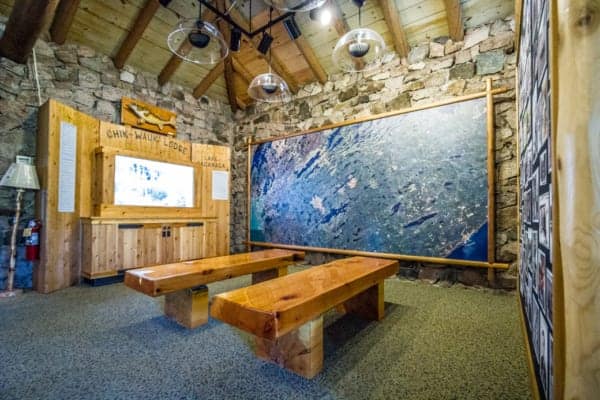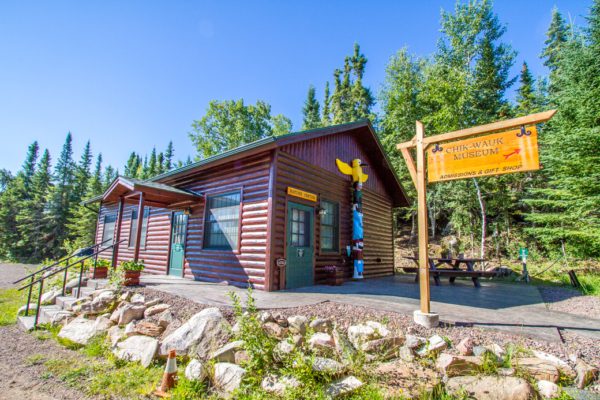
The Gunflint Trail and the Boundary Waters Canoe Area Wilderness are rich in history. The history dates back several centuries when the area was a Native American hunting area. Back then, the Gunflint Trail was just a path in the woods. Today, the Gunflint Trail 56-mile is a paved road that is home to many permanent – and many more seasonal – residents. It’s also home to the BWCA, a popular nature and remote destination for visitors from all over the world. Chik-Wauk Museum and Nature Center strives to gather this rich history into a living museum and nature center. Helping visitors understand what life was – and is – like on the Gunflint Trail.
About Chik-Wauk Museum and Nature Center
 The Museum’s focus is primarily on the past 100 years when year-round non-Indigenous residents started making their homesteads on the many lakes that dot the area. Many families have been in the area for generations and have shared their stories and photographs with the museum.
The Museum’s focus is primarily on the past 100 years when year-round non-Indigenous residents started making their homesteads on the many lakes that dot the area. Many families have been in the area for generations and have shared their stories and photographs with the museum.
However, the museum does still touch on the early years of the Gunflint Trail. There are the stories of the original French voyageurs who came into the area to trap beaver, in addition to stories from entrepreneurs who saw the Gunflint Trail as an opportunity for tourism and opened the first resorts in the area. There are tales of adventurers and fishermen who decided to share their love of this pristine area by opening outfitters and tour companies. Then there are the stories and photos of other residents who were just looking for a place to settle down. Searching for somewhere to live in peace and harmony with nature and found the Gunflint Trail provided them with just that.
The museum include the main museum building, the nature center, a watercraft building, and a re-created historic cabin.
Explore the Museum – History and Ecology
 Inside the museum, you walk into a room dedicated to the local ecology. This room boasts displays of animals and plants that are native to the area. In the back room, there is a theater area where these stories are told by those who lived them. There are photos surrounding the theater area of the faces and names of the people who have helped to open the Gunflint Trail area up to visitors.
Inside the museum, you walk into a room dedicated to the local ecology. This room boasts displays of animals and plants that are native to the area. In the back room, there is a theater area where these stories are told by those who lived them. There are photos surrounding the theater area of the faces and names of the people who have helped to open the Gunflint Trail area up to visitors.
Other sections feature artifacts showing what life was like for the earliest settlers of the Gunflint Trail. There’s a rotating display featuring a different theme/topic each year, so there’s always something new to see. Some displays are even interactive making it the perfect place to bring the kids. Children and adults can get a feel for how much weight a voyageur carried during treks into this vast wilderness area. Kids will love the museum scavenger hunt (ask the person at the desk for the sheet!).
A Museum Rich in History
The building itself is an iconic piece of Gunflint Trail history. It was once home to the Chik-Wauk Lodge on Saganaga Lake. The Chik-Wauk Lodge was originally built in 1932 by Ed Nunstedt as a fishing resort. It was a popular retreat and was in operation until 1978 when the building and the land were sold to the U.S. Forest Service. During its heyday, the resort had 11 cabins on its property.
After the Forest Service acquired the cabins they dismantled them and auctioned them off. The removal of the cabins left only the main lodge building on the site. The lodge sat empty for 3 decades between the closure of the Chik-Wauk Lodge and the opening of the Chik-Wauk Museum in 2010. In 2007 the building was placed on the National Register of Historic Places and any modifications made to the building to accommodate the museum were done in a way that preserved the building in as much of its original state as possible. While the original cabins are gone, one re-created cabin has been set up to show what it may have looked like back in the 1930s and can be toured as part of the museum.
Explore Nature and the Nature Center
 Chik-Wauk’s 50-acre grounds include a series of nature trails that families can explore and learn about the local ecology together. In 2016 they built The Nature Center building. This building is a treasure trove of natural resources, activities, and ideas for your hike around the museum grounds.
Chik-Wauk’s 50-acre grounds include a series of nature trails that families can explore and learn about the local ecology together. In 2016 they built The Nature Center building. This building is a treasure trove of natural resources, activities, and ideas for your hike around the museum grounds.
The Nature Center also hosts guest speakers and activities covering a variety of topics throughout the summer months. There are also several fun games and activities on the grounds that help children experience a little bit about life on the Gunflint Trail throughout the centuries as part of Chik-Wauk’s family-based Naturalist Program.
Every Watercraft Has a Story
The most recent addition to the museum is the Watercraft Exhibit Building, opened in 2019. The building houses historic canoes and other watercraft that hold significant historic importance on the Gunflint Trail. One of these boat is the one used by Justine Kerfoot, one of the last remaining people allowed to live inside the area that is now the Boundary Water’s Canoe Area Wilderness. But, in side the Watercraft Building, every watercraft has a story to tell. Learn more about the primary mode of transportation in the Gunflint Trail community inside the Watercraft Exhibit Building.
Experience It Yourself
This is a family-friendly museum and nature center that will keep adults and children entertained for hours. We do recommend you plan to spend at least 3 hours here in order to be able to really enjoy learning the history of the area and exploring the network of trails. Check out Chik-Wauk Museum’s website Here for more information, hours and dates of operation, and a schedule of events including guest speakers. You can also connect with Chik-Wauk Museum on Facebook. Chik-Wauk Museum operates in partnership with The Gunflint Trail Historical Society.
Watch Now
Check out our 2018 video of the museum and interview with museum manager, Bonnie Shudy.
Listen In
Joe and Jaye visited Chik-Wauk Museum and Nature Center during their series on the Gunflint Trail on the Exploring the North Shore Podcast.
